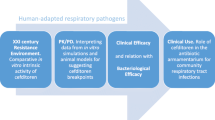Abstract
Background and objective: There is a general concern about the use of multi-source (generic) antibacterials in the clinical setting with registration based solely on bioequivalence data. In order to address this concern, two modified-release formulations of clarithromycin (i.e. the originator Klacid XL® and the generic Klarithran MR®) were compared in patients with acute community-acquired respiratory tract infections.
Methods: Patients presenting with tonsillopharyngitis, sinusitis or pneumonia were randomized to receive either of the test drugs provided they clinically qualified for empirical clarithromycin treatment. The study endpoints were clinical and bacteriological cure rates, tolerability and safety. The study was designed to test for non-inferiority with regard to cure rates.
Results: The main outcome of this study was that both agents had similar clinical (non-inferior) and bacteriological cure rates and demonstrated no difference in tolerability in patients. The study also demonstrated the clinical efficacy of clarithromycin when used as empirical treatment in patients with respiratory tract infections in community practice (i.e. 95% clinical cure rate).
Conclusion: The clarithromycin extended-release multisource product (Klarithran MR®) does not differ significantly from the originator (Klacid XL®) and the clinical cure rate of the generic formulation is non-inferior to that of the originator. The two formulations are tolerated similarly.








Similar content being viewed by others
References
Fogarty CM, Kohno S, Buchanan P, et al. Community-acquired respiratory tract infections caused by resistant pneumococci: clinical and bacteriological efficacy of the ketolide telithromycin. J Antimicrob Chemother 2003 Mar 13; 51: 947–55
Lieberman D, Shvartzman P, Lieberman D, et al. Etiology of respiratory tract infection in adults in a general practice setting. Eur J Clin Microbiol Infect Dis 1998; 17: 685–9
Klugman KP. Implications for antimicrobial prescribing of strategies based on bacterial eradication. Int J Infect Dis 2003; 7: S27–31
Dagan R, Klugman KP, Craig WA, et al. Evidence to support the rationale that bacterial eradication in respiratory tract infection is an important aim of antimicrobial therapy. J Antimicrob Chemother 2001; 47: 129–40
Feldman C, Brink AJ, Richards GA, et al. Management of community-acquired pneumonia in adults. S Afr Med J 2007; 97(12): 1296–306
Gotfried MH. Clarithromycin (Biaxin) extended-release tablet: a therapeutic review. Expert Rev Anti-infect Ther 2003; 1(1): 9–20
Esposito S, Noviello S, Boccazzi A, et al. Management of upper respiratory tract infections in primary care in Italy: a national survey. Int J Antimicrob Agents 2001; 17: 189–94
Brink AJ, Working Group of the Infectious Diseases Society of Southern Africa. Guideline for the management of upper respiratory tract infections. S Afr Med J 2004 Jun; 94(6): 473–84
Anzueto A, Norris S. Clarithromycin in 2003: sustained efficacy and safety in an era of rising antibiotic resistance. Int J Antimicrob Agents 2004; 24: 1–17
Drehobl MA, De Salvo MC, Lewis DE, et al. Single-dose azithromycin microspheres vs clarithromycin extended release for the treatment of mild-to-moderate community-acquired pneumonia in adults. Chest 2005; 128: 2230–7
Clinical and Laboratory Standards Institute. Performance standards for antimicrobial susceptibility testing. 17th Informational Supplement 2007 January 27; 1: M100–S17
AIDS Clinical Trial Group. Table of grading severity of adverse experiences. Rockville (MD): Division of Aids, National Institute of Allergy and Infectious Diseases, 1996
Darkes MJM, Perry CM. Clarithromycin extended-release tablet: a review of its use in the management of respiratory tract infections. Am J Respir Med 2003; 2(2): 175–201
Murray JJ, Solomon E, McCluskey D, et al. Phase III, randomized, double-blind study of clarithromycin extended-release formulations in the treatment of adult patients with acute maxillary sinusitis. Clin Ther 2000; 22: 1421–32
Pichichero ME. Pathogen shifts and changing cure rates for otitis media and tonsillopharyngitis. Clin Pediatr 2006; 45: 493–502
Bloom BS. Daily regimen and compliance with treatment [editorial]. BMJ 2001; 323: 647
Rudd P, Lenert L. Pharmacokinetics as an aid to optimizing compliance with medications. Clin Pharmacokinet 1995; 28: 1–6
Robinson DH, Narducci WA, Ueda CT. Drug delivery and administration. In: DiPiro JT, Talbert FL, Yee GC, editors. Pharmacotherapy: a pathophysiologic approach. 4th ed. Stamford (CT): Appleton & Lange, 1999: 49–76
Denny FW, Wannamaker LW, Brink WR, et al. Prevention of rheumatic fever: treatment of the preceding streptococcal infection. Landmark article May 13, 1950. JAMA 1985; 254: 534–7
Shaw E, Anderson JG, Maloney M, et al. Factors associated with noncompliance of patients taking anti-hypertensive medications. Hosp Pharm 1995; 30: 201–3, 206-7
National Antimicrobial Surveillance Forum (NASF): South Africa, 2005
Acknowledgements
This study was sponsored by Ranbaxy Laboratories (SA) (Pty) Ltd.
Prof. Snyman, Prof. Grobusch, Dr Henning, Dr Rabie, Dr Hira, Dr Parshotam and Dr Mithal act as clinical research consultants to pharmaceutical companies, including Ranbaxy, in South Africa. Prof. Schoeman acts as a biostatistical consultant for the entire pharmaceutical industry in South Africa. Dr Singh and Mr Ramdas are employees of Ranbaxy (SA) (Pty) Ltd.
Author information
Authors and Affiliations
Corresponding author
Rights and permissions
About this article
Cite this article
Snyman, J.R., Schoeman, H.S., Grobusch, M.P. et al. Generic versus Non-Generic Formulation of Extended-Release Clarithromycin in Patients with Community-Acquired Respiratory Tract Infections. Clin. Drug Investig. 29, 265–274 (2009). https://doi.org/10.2165/00044011-200929040-00005
Published:
Issue Date:
DOI: https://doi.org/10.2165/00044011-200929040-00005




